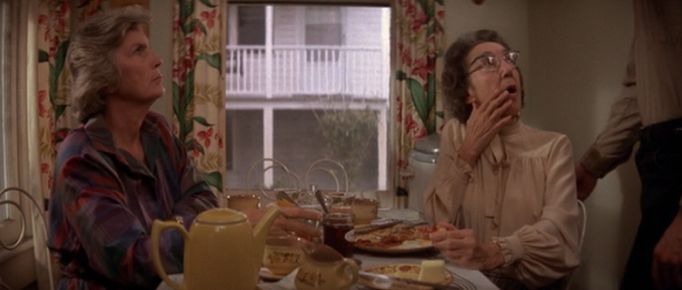 Back to selection
Back to selection
The Blue Velvet Project
Blue Velvet, 47 seconds at a time by Nicholas Rombes
The Blue Velvet Project, #114

Second #5358, 89:18
When Blue Velvet is funny, it is very funny. This shot opens with Jeffrey’s mother and his Aunt Barbara (the late, great, Frances Bay) looking up from the breakfast table at something, aghast. However, in a sharp instance of delayed decoding, we don’t see what they see for several seconds. For all we know, they could be looking in frozen horror at an intruder, or a monster (perhaps the entity behind the Winkie’s dumpster from Mulholland Drive), or something visible only to them. It is only at this moment that we see what they see: Jeffrey, whose bruised face shocks them.
There is the recurrence of curtains used as a framing device; Jeffrey (like Ben) is about to enter the space between them, as if taking the stage. And there is the odd contraption just behind Aunt Barbara. But most of all there is the presence of Frances Bay who would appear again in several Lynch projects including Twin Peaks: Fire Walk With Me as Mrs. Tremond, who hands Laura a framed picture of a doorway, a doorway which she will enter in a dream.
In Brian Evenson’s story “Discrepancy,” from Windeye, a woman becomes plagued by a temporal break resulting in an ever-increasing delay between her experiences and the sounds of those experiences:
There was a day she noticed a discrepancy between sound and image on the television, and found no matter how she messed with the tracking she could not make it go away. . . .
And now, she told him [a doctor she has sought out for help], it was not just television but other things as well. Like people. Even he, she told the doctor’s cousin, also a doctor, was off. She would see his lips move and then only a moment later did she hear his words.
She has fallen out of time which is, in a sense, what movies like Blue Velvet do. They are echoes from the past on at least two levels: as a sort of documentary record of reality and as a fictional representation of reality. The yellow teapot on the table, for instance, is just a prop, but once activated in the space of Blue Velvet it becomes a yellow teapot in a different reality. Once we see it on that kitchen table, it becomes fixed as a tiny piece of narrative.
In Parallel Worlds, the theoretical physicist Michio Kaku summarizes the theory postulated by Niels Bohr, Einstein’s contemporary and great foil, that reality behaves in a remarkably counter-intuitive way at the sub-atomic level:
Before an observation is made, an object exists in all possible states simultaneously. To determine which state the object is in, we have to make an observation, which ‘collapses’ the wave function, and the object goes into a definite state. The act of observation destroys the wave function, and the object now assumes a definite reality.
In its own way, Blue Velvet is about the act of seeing (just follow the gazes of Jeffrey’s mother and aunt in this frame) and how that act actually changes things. In this frame, the comforting but also terrifying presence of Frances Bay constitutes a visual logic all her own, provided you’ve seen her before (after?) in Twin Peaks, season two, and Fire Walk With Me.
In that case, the look on her face in this instant is not one of shock, but of horror.
Which is to say: she recognizes, in Jeffrey, a monster.
Over the period of one full year — three days per week — The Blue Velvet Project will seize a frame every 47 seconds of David Lynch’s classic to explore. These posts will run until second 7,200 in August 2012. For a complete archive of the project, click here. And here is the introduction to the project.
